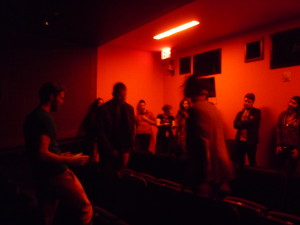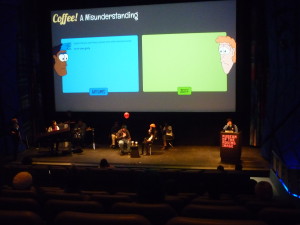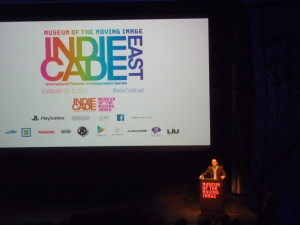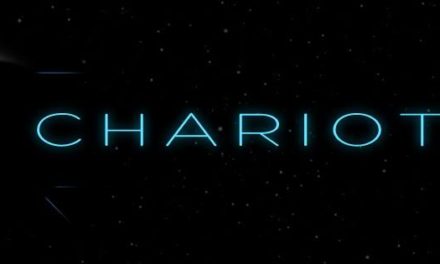“Dark Room Sex Game is supposed to have a blank black screen, right?”
“Yes. But it’s also out of order.”
– Overheard on Friday in the Exhibit Hall
On a cold Valentine’s Day weekend, I descended upon the Museum of the Moving Image for IndieCade East. The convention’s organizers, in their infinite wisdom, had given me a three-day pass for the event, something that came as kind of a welcome shock to me, and I was nervous and determined to prove myself all the more. I was expecting a normal convention.
Instead, I found a place where Gone Home sat side-by-side with freeware visual novels and abstract Rod Humble projects. Where a room full of party-goers clears a space on the floor for two people with red balloons clipped to them goes through an elaborate mock-duel that shares some minor commonalities with iaijutsu. Where Nintendo shared space with LIU grad student projects and a show-and-tell section housing an antique telegraph game. A place where it felt like anything could happen, and no matter how slick some of it looked (and let’s face it, some of those displays? Pretty slick), it never felt particularly far from the roots. It felt accessible. Sure, it was big, but there’s comfort in knowing everyone in the room is as big a geek as you.
And it strikes me that this is the kind of thing I want to see more of. These moments. People just playing games unhindered. Fumbling through the rules of a game about consensual tentacle sex without any input from the designer. Trying to brain digital representations of each other with candelabrum “as God and Liberace intended.” I want to discover, and I want other people to discover. And most importantly, I just want to play some damn games with people.
And this is why IndieCade East represents for me everything right about the indie gaming scene, and how to change things for the better moving forward. So allow me to try and show you what I like so much about all of this as I attempt to take you through my IndieCade East experience– an outsider’s IndieCade East experience. Expect rambling below.
The Love and Rejection Showcase
This year’s curated showcase had the theme of “Love and Rejection.” The theme covered a lot of ground, from stories that directly addressed love, romance, and rejection (like Gone Home, The Marriage, and Save the Date) to games about intimacy and the importance of consent and agency (Consentacle, reProgram) to games that were about sex (How Do You Do It?, Ute, and Dark Room Sex Game*). The “rejection” end of the spectrum tended towards games that had been rejected for one reason or another, including Super Columbine Massacre RPG!, Wolfenstein 3-D (rejected by Nintendo and banned in Germany for its violence and depictions of Nazi iconography, and exhibited aside its infamous pirate-cartridge “twin” Super Noah’s Ark 3-D).
Even with the games I had played, seeing them in this new context and exhibited instead of loading them up on my computer at home felt kind of special. I’ve also wanted to play Consentacle for months ever since hearing about it, as I believe playing a consent-and-trust-based human-tentacle sex card game is a unique experience everyone should have at least once. Thankfully, by Sunday I finally got to sit down with it, and I have to say that I have never played anything like it.
And that’s really the draw of coming to the festival. Experimentation. Playing things outside one’s comfort zone. Doing things outside one’s comfort zone. Finding things that you might not have looked for, or might have seen but didn’t give a second look until you saw them in this context. With the energy and the life that goes into this festival, it’s interesting to see things in a new light.
Night Games
Speaking of outside a comfort zone, we have Night Games. Night Games is an annual curated event on Saturday at the conference, featuring more experimental, social, and active games. As someone who is usually somewhere on a scale of “mildly frightened of other people” to “outright terrified to approach anyone,” this was something of a different experience for me, and one both unnerving and also surprisingly pleasant. The biggest game of the night, or at least the one I saw the most people playing, was a game called Under the Hood, a combination of a hidden-roles game and a sort of mock duel. People would ask each other questions to find out if another player was one of the wolves hiding at the event (because wolves would always lie) and then challenge them to a duel with their arms serving as a hatchet. Players also identified themselves by clipping balloons to themselves: Red for players, black for moderators.
The other game I played and really enjoyed was Coffee: A Misunderstanding, a piece of experimental digital theater where two “actors” wearing hats to differentiate their characters were fed lines via smartphones by two “puppetmasters” who picked dialogue choices off of their own smartphones. Coffee also featured music by a house band, including a pianist who would do a little flourish whenever the actors and puppetmasters unlocked an achievement by going down certain narrative paths. Despite following a basic script, the story took a lot of unexpected narrative turns, including one playthrough where the characters played by the actors got stuck in a Groundhog Day-style time loop, another where they argued over cellular structure, and a third involving several awkward confessions.
Though I think what I liked most about all of it was the energy that went into it. There was a kind of loose, nervous sense of play that ran through everything (Of course. They were games), and it all seemed a lot more welcoming than perhaps the day-to-day festival had. It was certainly the staging area for some of the weirder moments for me, and I can certainly recommend it based on the unique qualities. It’s a good way to loosen up a little socially, and you will see things that I’m fairly certain are uncommon outside of Night Games. Unique social experiences are, with few exceptions, rarely a bad thing.
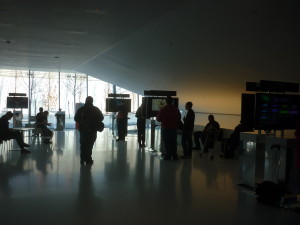
Show and Tell/Sponsored Sections
And speaking of unique experiences, the show and tell section of the conference had its share. While the larger companies stuck mainly to up-and-coming video games, the smaller, more independent outfits had no qualms about bringing anything and everything to the table. And this is really the spirit of indie for me. Not so much the larger groups or the established titles, but the constant experimentation.
Among the exhibits, there was a man showing off a game played with an antique telegraph send-receive for a controller hooked up to a monitor. A telegraph. In another corner, a woman was showing off her text adventure game and actually taking notes on her parser and commonly used verbs while people played. There was an LIU game for the Oculus Rift that played with depth of field so much two people nearby wondered if it was making me motion-sick while I played** I don’t see this stuff in real life. Hell, I don’t see this kind of thing when I go to cons. These are the kinds of things that should be preserved. Fostered.
The Panels
I saved the panels for last mainly because I am going to be talking the most about them, and also because this is the subject that gets me the most. It’s no secret that gaming has had a definite problem with diversity, and that problem has metastasized into the ugly, gaping cyst on the internet. I have watched people– people I thought were rational human beings– screaming at each other over inclusivity, which, for the record, is an issue we as a species should have solved already. It’s made me tense. Very tense.
And honestly? What I saw at IndieCade East is a step in the right direction. The panels were highly diverse, featuring a wide range of speakers from various disciplines and ethnicities, and all over the gender/sexuality spectrum. And not “diverse” in the way I’ve seen at some conferences, but in the egalitarian sense that it seemed like anyone who actually had something to say got to speak. While I could ramble about the various panels I saw and what they mean, since this is the last section (I’m already dangerously over-wordy here), I’d like to tell you what I took away from the numerous panels on diversity and including more people in the indie scene. And that is:
Things need to be changed, not fixed
In her keynote “Diversity in Audience, Diversity in Creators,” Dr. Mary Flanagan started out by reminding the audience that BASIC was a platform designed with equality in mind. In her “mini-manifesto” presented at the end of her talk, Flanagan also warned against the “designer’s problem,” that one can fix issues with something or find a “solution,” when really the only option is to continually move towards a more optimal state and improve it.
This was reinforced by an earlier talk, Stacey Mulcahy‘s “Bridging the Gender Gap for Future Young Game Makers,” where Mulcahy said she thought that “fixing things” was “like putting spackle over a hole on a wall.” Mulcahy also talked about how she was normalizing positive attitudes with her Young Game Makers workshops by not only treating everyone simply as individuals who make games instead of dividing them by gender or any particular grouping, but also by letting them know when something isn’t right by telling them.
Which brings up another good point about the panels mentioned above: The ideas advanced in both of them were meant to get people to question and think about their own ideas to alter them for the better. Flanagan referred to her studies with Tiltfactor involving the games Awkward Moments and Buffalo (among others)***, games she designed to help people question their biases and more harmful attitudes via play.
This is something I can actually sort of get behind, because I am a firm believer that the only way to actually change things– change, not just fix— is to actually talk about problems, and try to remember that the person on the other side of the aisle has been driven to their conclusions the same way. To get people to change their minds organically so we can have a better space for everyone. So everyone can experience the weird, wild, beautiful thing that is the indie scene.
And that’s the thing I most wanted to share. That while it’s difficult, and while changing attitudes and separating the people from ideology is arduous, it’s the correct path. I don’t want to “fix” the problem with the gaming community. I don’t think the problems gaming or digital art or whatever people want to call it really have a definite “fix”. But we can move towards optimal states. And each optimal state takes us further away from the problem and into newer, possibly more comfortable states, and optimal states beyond that.
I think that, and all the things I saw at IndieCade, are the things worth fighting for. Don’t you?
Full disclosure: I received a press pass for this event. Fuller disclosure: I may have nervously mumbled about psychology and games with Mary Flanagan very briefly.
*I had way too much fun with Dark Room Sex Game. I’m pretty sure it wasn’t supposed to be played alone and while standing on the other side of the room. And for that I apologize. Also, while it worked in the context of the game (that being a rhythm game about having sex in a dark room), I do not remember sex being that loud.
**It may be the sleep deprivation as I finish this article, but I am getting disoriented and queasy just thinking about it. That’s the mark of a good game. The experience may have passed, but the sensations stay with you.
***Full disclosure on this, I wrote down notes from the keynote talk on the studies, but I did not write down which studies I was allowed to talk about outside of said lecture due to review status and whatnot. So I’m erring on the side of caution. My apologies.


